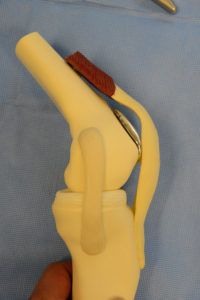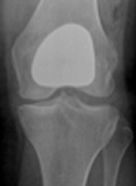Patellofemoral replacement is a specialized type of partial knee replacement that addresses isolated wear between the back of the patella (kneecap) and the front of the femur (thigh bone). Although patellofemoral replacements are not as common as other types of knee replacements, they offer many benefits to those with wear limited to the front of the knee. These benefits include less invasive surgery that preserves healthy bones and ligaments, faster recovery, less blood loss, and a more normal feeling knee with better range of motion. A patellofemoral knee replacement can also be easily converted into a total knee replacement if necessary.




Did You Know?
Frequently Asked Questions:
Am I a candidate for a patellofemoral knee replacement?
Patellofemoral replacement addresses arthritis around the kneecap that typically only affects the undersurface of the kneecap. It is not ideal for individuals who have inflammatory or crystalline arthritis, or those with wear elsewhere in the knee. Patients with patellofemoral arthritis can walk well on flat surfaces but have trouble on inclines, stairs and rising from a chair. To determine if you are an ideal candidate for a patellofemoral knee replacement, schedule a consultation with Dearborn & Associates, the Bay Area leaders in patellofemoral surgery.
How are patellofemoral knee replacements performed?
At Dearborn & Associates, your patellofemoral knee replacement will be performed under spinal anesthesia with a specialized nerve block in the thigh. You may elect to have sedation as well. The procedure takes less than 45 minutes. There are three main steps to a patellofemoral knee replacement:
- Your surgeon will make an incision in the knee
- The damaged cartilage and a thin layer of bone will be removed from the underside of the patella.
- A space for a recessed metal piece on the front of the femur will be created that will fit flush with the rest of your bone surface.
- The metal piece and a plastic patella button will be cemented into place.
What can I expect during recovery?
After your operation, you can expect to spend about an hour in the recovery room area, until the spinal anesthetic wears off. Within a few hours, one of our physical therapists will have you up and moving as they show you post-operative exercises and techniques for everyday tasks. You will be ready to go home 4-5 hours after surgery.
During your recovery process, a walker or cane will be needed initially. You may also desire a cooling unit to help with postoperative discomfort. You can expect to have a physical therapist come to your house to assist you with an exercise program to promote proper healing. Follow up visits are also usually scheduled at the 2-week, 6-week, and 3-month marks.
In most cases, you should be able to walk independently within 2 weeks after surgery. At the 6-week mark, you will be able to resume most of your regular activities.
Schedule a consultation with Dearborn & Associates in Menlo Park and Fremont, CA today to see if a patellofemoral knee replacement is the right treatment for you!





